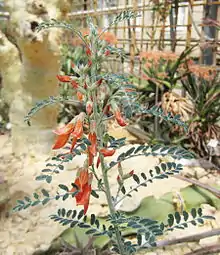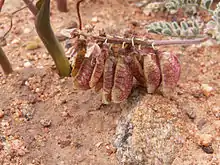Sutherlandia frutescens
Sutherlandia frutescens (cancer bush,[2] balloon pea, sutherlandia, phetola ("it changes") in seTswana, and insiswa ("the one that drives away the darkness") in isiZulu; syn. Colutea frutescens L., Lessertia frutescens (L.) Goldblatt & J.C.Manning) is a southern African legume once used as a traditional medicine. It is a shrub with bitter, aromatic leaves. Red-orange flowers appear in spring to mid-summer.[3]
| Sutherlandia frutescens | |
|---|---|
 | |
| Scientific classification | |
| Kingdom: | |
| (unranked): | |
| (unranked): | |
| (unranked): | |
| Order: | |
| Family: | |
| Subfamily: | |
| Tribe: | |
| Genus: | |
| Species: | S. frutescens |
| Binomial name | |
| Sutherlandia frutescens | |
Cultivation

Sutherlandia frutescens is a small bush growing up to about 1 m (39 in) high. It is native to dry parts of southern Africa, preferring full sun but tolerant of a wide variety of soil types. It is a tough plant, hardy, fast growing and drought tolerant but short lived. Seeds germinate readily in around two to three weeks and established plants self-seed readily. Seedlings may be vulnerable to damping off, but provided it is in well-drained soil, it grows readily and is not very vulnerable to pests.[3]
Traditional uses
Despite Sutherlandia frutescens having been used by a wide variety of indigenous communities throughout South Africa, the South African Herbal Science and Medicine Institute (SAHSMI) is participating in discussion of bio-prospecting in order to be able to claim intellectual property rights concerning the use of Sutherlandia extracts.
References
- "Sutherlandia frutescens". Germplasm Resources Information Network (GRIN). Agricultural Research Service (ARS), United States Department of Agriculture (USDA). Retrieved 2008-03-03.
- "Sutherlandia frutescens". Natural Resources Conservation Service PLANTS Database. USDA. Retrieved 4 December 2015.
- Phakamani M' Afrika Xaba & Alice Notten (April 2003). "Sutherlandia frutescens". Kirstenbosch National Botanical Garden.